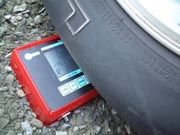
There are lots of useful tools for electrical work: multimeters, current clamps, and wands that light up next to a live wire. To this day, we really can't tell that much about the refrigeration circuit. The pressure gauges in your manifold are coarse, and they can't show the smaller things like sucking small slugs of liquid. Your thermometer tells you the suction line temperature, but you've got to find the right line on your wallet card that tells what pressure for R-407C gives 45 degrees dew point. But the card only has values for 40 degrees and 50 degrees, so you have to take a guess. Or do you say that the 76 psi you remember for R-22 is close enough, since you are doing a drop-in replacement with R-407C for it?
There is no reason why smart tools can't solve these refrigeration circuit problems. That's why I'm excited to share my invention with you.
The Digital Refrigeration System Analyzer (DRSA) helps take care of your refrigerant system headaches. It gives you all the information you need at your fingertips. Mounted on your charging manifold, it's easy to handle. It shows you all the hidden pressure fluctuations you've been missing, saving you time and showing you what is wrong.
In the old days of R-12, -22, and -502, a low-side gauge was all you needed for service. These days, we need precise information to diagnose more subtle issues. More problems in today's refrigeration systems are within the refrigerant circuit as a result of new refrigerants, oils, and resultant toxic brews. Traditional Bourdon tube pressure gauges and wallet cards do not give you the precision necessary to make accurate or timely decisions about what needs fixing.

A More Precise Tool
Besides an accurate digital pressure reading, the DRSA has a dynamic offset bar graph. The graph segments show the changes happening to low-side and high-side pressure, down to 1/4 psi movements. These movements are like a heart beat - a system with a problem such as a little bit of liquid floodback or a wandering TEV is easy to spot; a healthy one is obvious. Believe it or not, most people have never seen these important movements. With the DRSA, you will have the ability to spot problems you would have never known were there in the past.
For example, if you assumed R-22 and R-407C have identical SSTs above, you would have less superheat than you think. The actual dew point for R-407C at the old system pressure of 76 psi is 48 degrees, not 45 degrees. The Digi-Cool analyzer tells you right on the screen when you set your pressure, so there's no guessing. You would also know that the pressure you actually want to use is 72 psi.

Since it presents accurate, constantly updated SSTs, the DRSA reduces charging times by allowing you to charge based on superheat. With readings in inches Hg, drawing a vacuum on a system for everyday work is simple. However, we recommend a micron vacuum gauge when eliminating moisture or determining the tightness of a system by deep vacuum draw.

Work Smarter, Not Harder
HVACR work is much different nowadays; there are many more factors and possible problems. Consumers and business owners demand that we be more efficient and productive to keep their business and earn future projects. We can accomplish this with more accurate, time-saving tools that give us superior information quicker.The DRSA's detailed bar graph helps you to clearly see the exact problem. This tool provides the information necessary for fast and accurate diagnosis, whether you work with residential A/C, commercial rooftop A/C, supermarket refrigeration, or low temperature cascade systems. It helps you to work smarter, not harder.
Doug Lockhart, A.Sc.T, is an HVACR technician and founder of Digi-Cool Industries Ltd., Duncan, British Columbia. For more information, e-mail info@digi-cool.com or visit www.digi-cool.com.
Publication date: 05/31/2004

Report Abusive Comment